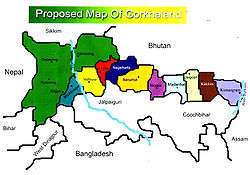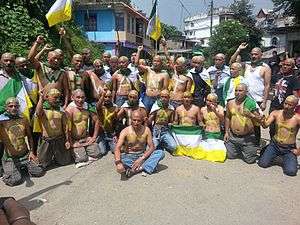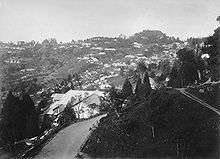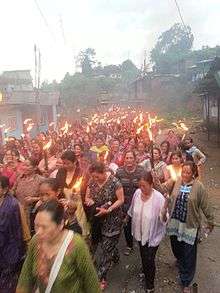Gorkhaland
| Gorkhaland | |
|---|---|
| Proposed state | |
 | |
| Country |
|
| State | West Bengal |
| Proposed Capital | Darjeeling |
| Languages | |
| • Official | Nepali |
Gorkhaland is a proposed state in India demanded by the people of the Darjeeling Hills and the people of Indian Gorkha ethnic origin on the Dooars of West Bengal on the basis of ethno-linguistic rights.[1] The movement for Gorkhaland has gained momentum in the line of ethno-linguistic-cultural sentiment of the Indian peoples who desire to identify themselves as Indian Gorkhas.[2] Two mass movements for Gorkhaland have taken place under the Gorkha National Liberation Front (1986–1988) and Gorkha Janmukti Morcha (2007–present).
History of the demand
The demand for a separate administrative unit in Darjeeling has existed since 1907, when the Hillmen's Association of Darjeeling submitted a memorandum to Minto-Morley Reforms demanding a separate administrative setup.[3] In 1917, the Hillmen's Association submitted a memorandum to the Chief Secretary, Government of Bengal, the Secretary of State of India and the Viceroy for the creation of a separate administrative unit comprising the Darjeeling district and adjoining Jalpaiguri district.

In 1929, the Hillmen's Association again raised the same demand before the Simon Commission. In 1930, a joint petition was submitted by Hillmen's Association, Gorkha Officers Association and the Kurseong Gorkha Library to the Secretary of the State of India, Samuel Hoare for separation from the province of Bengal. In 1941, the Hillmen's Association under the presidency of Rup Narayan Sinha urged the Secretary of State of India, Lord Pethick Lawrence, to exclude Darjeeling from the province of Bengal and make it a Chief Commissioners Province.
In 1947, the undivided Communist Party of India (CPI) submitted a memorandum to the Constituent Assembly with copies to Pt. Jawaharlal Nehru, the Vice President of the Interim Government, and Liaquat Ali Khan, Finance Minister of the Interim Government, demanding the formation of Gorkhasthan comprising Darjeeling District, Sikkim and Nepal.

In Independent India, the Akhil Bharatiya Gorkha League (ABGL) was the first political party from the region to demand greater identity for the Indian Gorkha ethnic group and economic freedom for the community, when in 1952, under the presidency of N.B. Gurung, the party met Pt. Jawaharlal Nehru, the then Prime Minister of India in Kalimpong and submitted a memorandum demanding the separation from Bengal.
In 1980, under the presidency of Indra Bahadur Rai, the Pranta Parishad of Darjeeling wrote to the then Prime Minister of India Indira Gandhi with the need to form a new state in Darjeeling.
A new violent movement for a separate state of Gorkhaland was started in 1986 by Gorkha National Liberation Front (GNLF) led by Subhash Ghisingh. The agitation ultimately led to the establishment of a semiautonomous body in 1988 called the Darjeeling Gorkha Hill Council (DGHC) to govern certain areas of Darjeeling district. However, in 2007, a new party called the Gorkha Janmukti Morcha (GJM) raised the demand for a separate state of Gorkhaland once again.[4] In 2011, GJM signed an agreement with the state and central governments for the formation of Gorkhaland Territorial Administration, a semiautonomous body that replaced the DGHC in the Darjeeling hills.
History of the area
Before the 1780s, the area of Darjeeling formed a part of dominions of the Chogyal of Sikkim, who had been engaged in unsuccessful warfare against the Gorkhas of Nepal. Around 1780, the Gorkhas invaded Sikkim and captured most part of it, which included Darjeeling and Siliguri. By the beginning of the 19th century, they had overrun Sikkim as far eastward as the Teesta River and had conquered and annexed the Terai.
In the meantime, the British were engaged in preventing the Gorkhas from overrunning the whole of the northern frontier. The Anglo-Gorkha war broke out in 1814, which resulted in the defeat of the Gorkhas and subsequently led to the signing of the Sugauli Treaty in 1815. According to the treaty, Nepal had to cede all those territories that the Gorkhas had annexed from the Chogyal of Sikkim to the British East India Company (i.e. the area between Mechi River and Teesta River).

Later in 1817, through the Treaty of Titalia, the British East India Company reinstated the Chogyal of Sikkim, restored all the tracts of land between the Mechi River and the Teesta river to the Chogyal and guaranteed his sovereignty.
The controversy did not end there. In 1835, the hill of Darjeeling, including an enclave of 138 square miles (360 km2), was given to the British East India Company by Sikkim, executed with a Deed of Grant. In November 1864, the Treaty of Sinchula was executed, in which the Bengal Dooars, which originally had been under the Cooch Behar state and taken over by Bhutan in the second half of the eighteenth century, along with the passes leading into the hills of Bhutan and Kalimpong were ceded to the British by Bhutan.[1] The present Darjeeling district can be said to have assumed its present shape and size in 1866 with an area of 1234 sq. miles.
Prior to 1861 and from 1870–1874, Darjeeling District was a "Non-Regulated Area" (where acts and regulations of the British Raj did not automatically apply in the district in line with rest of the country, unless specifically extended). From 1862 to 1870, it was considered a "Regulated Area". The term "Non-Regulated Area" was changed to "Scheduled District" in 1874 and again to "Backward Tracts" in 1919. The status was known as "Partially Excluded Area" from 1935 until the independence of India.
Agitation under GNLF and formation of DGHC
In the 1980s, Subhash Ghisingh raised the demand for the creation of a state called Gorkhaland within India to be carved out of the hills of Darjeeling and areas of Dooars and Siliguri terai contiguous to Darjeeling. The demand took a violent turn, which led to the death of over 1,200 people. This movement culminated with the formation of Darjeeling Gorkha Hill Council (DGHC) in 1988. The DGHC administered the Darjeeling hills for 23 years with some degree of autonomy.
The fourth DGHC elections were due in 2004. However, the government decided not to hold elections and instead made Subhash Ghisingh the sole caretaker of the DGHC till a new Sixth Schedule tribal council was established. Resentment among the former councillors of DGHC grew rapidly. Among them, Bimal Gurung, once the trusted aide of Ghising, decided to break away from the GNLF. Riding on a mass support for Prashant Tamang, an Indian Idol contestant from Darjeeling, Bimal quickly capitalized on the public support he received for supporting Prashant, and was able to overthrow Ghisingh from the seat of power. He went on to found the Gorkha Janmukti Morcha raising the demand a state of Gorkhaland.[5]
Agitation under GJM

Ahead of the 2009 general elections in India, the Bharatiya Janata Party again announced its policy of having smaller states and to create two more states, Telangana and Gorkhaland, if they won the general election. GJM supported the candidature of Jaswant Singh of BJP, who won the Darjeeling Lok Sabha seat with 51.5% votes in his favour. In the July 2009 budget session of Parliament, three Parliamentarians— Rajiv Pratap Rudy, Sushma Swaraj and Jaswant Singh—strongly pleaded for creating a state of Gorkhaland.
The demand for Gorkhaland took a new turn with the assassination of Madan Tamang, leader of Akhil Bharatiya Gorkha League. He was stabbed to death allegedly by Gorkha Janmukti Morcha supporters on 21 May 2010, in Darjeeling, which led to a spontaneous shutdown in the three Darjeeling hill sub-divisions of Darjeeling, Kalimpong and Kurseong.[6][7] After the murder of Madan Tamang, the West Bengal government threatened action against Gorkha Janmukti Morcha, whose senior leaders are named in the FIR, meanwhile hinting discontinuation of ongoing talks over interim arrangement with the Gorkha party, saying it had "lost popular support following the assassination".[8]
On 8 February 2011, three GJM activists were shot dead (one of whom succumbed to her injuries later) by the police as they tried to enter Jalpaiguri district on a padyatra led by Bimal Gurung from Gorubathan to Jaigaon. This led to violence in the Darjeeling hills and an indefinite strike was called by GJM that lasted 9 days.[9]
In the West Bengal state assembly election, 2011 held on 18 April 2011, GJM candidates won three Darjeeling hill assembly seats, proving that the demand for Gorkhaland was still strong in Darjeeling. GJM candidates Trilok Dewan won from Darjeeling constituency, [10] Harka Bahadur Chhetri from Kalimpong constituency, and Rohit Sharma from Kurseong constituency.[11] Wilson Champramari, an independent candidate supported by GJM, also won from Kalchini constituency in the Dooars.[12]
Gorkhaland Territorial Administration
The memorandum of agreement for the formation of a Gorkhaland Territorial Administration (GTA), a semi-autonomous administrative body for the Darjeeling hills, was signed on 18 July 2011.[13] Earlier, during the West Bengal assembly election (2011) campaign, Mamata Banerjee had promised that the issue of Gorkhaland would be resolved. While Mamata implied that this would be the end of the Gorkhaland movement, Bimal Gurung reiterated that this was just another step towards statehood. Both spoke publicly at the same venue in Pintail Village near Siliguri, where the tripartite agreement was signed.[14] A bill for the creation of GTA was passed in the West Bengal Legislative Assembly on 2 September 2011.[15] The West Bengal government issued a gazette notification for the GTA Act on 14 March 2012, signalling preparations for elections for the GTA.[16] In the elections of the GTA held on 29 July 2012, GJM candidates won from 17 constituencies and the rest 28 seats unopposed.[17]
On 30 July 2013, Gurung resigned from the GTA citing both interference from the West Bengal government and the renewed agitation for Gorkhaland.[18]
2013 Agitation
On 30 July 2013, the Congress Working Committee unanimously passed a resolution to recommend the formation of a separate Telangana state from Andhra Pradesh to the INC-led central government.[19] This resulted in flaring up of demands throughout India, prominent among them were the demands for statehood for Gorkhaland in West Bengal and Bodoland in Assam.
Following a 3 days bandh,[20] GJM announced an indefinite bandh from 3 August.[21] Largely peaceful, political development took place in the background. With the West Bengal government armed with Calcutta high court order declaring the bandh as illegal, the government toughened its stand by sending a total of 10 companies of paramilitary force to quell any violent protest and arresting prominent GJM leaders and workers.[22] In response GJM announced a unique form of protest 'Janta Bandh', in which with no picketing or the use of force, the people in the hills were asked to voluntarily stay inside on 13 and 14 August.[23] This proved to be a major success and an embarrassment for the government.
After a marathon 'all party meeting' convened by the Gorkha Janamukti Morcha (GJM) on 16 August at Darjeeling, the pro Gorkhaland parties informally formed 'Gorkhaland Joint Action Committee'.[24] and jointly decided to continue the movement and exercise bandhs albeit through different names. For the first time in 106 years, all the major political parties of the hills agreed to come together and jointly take the agitation forward.
With demands for Union government intervention, the GJAC announced that agitation was to continue even after 18 August, with programs like 'Ghar Bhitre Janta' (People confided to home), processions with torches and huge human chains with black bands on the national highways,"
See also
References
- 1 2 Sailen Debnath, The Dooars in Historical Transition, ISBN 9788186860441
- ↑ "Why Gorkhaland". Gorkha Janmukti Morcha. Retrieved 6 October 2012.
- ↑ "The Parliament is the supreme and ultimate authority of India". Darjeeling Times. 23 November 2010. Retrieved 20 March 2012.
- ↑ "Demand for Gorkhaland raised again". The Hindu. Chennai, India. 16 November 2007. Retrieved 20 March 2012.
- ↑ "Indian Idol reignites demand for Gorkhaland in Darjeeling hills". Live Mint. 19 March 2008. Retrieved 20 March 2012.
- ↑ "Gorkha leader Madan Tamang killed, Darjeeling tense". The Indian Express. 21 May 2010. Retrieved 20 March 2012.
- ↑ "Gorkha leader Madan Tamang hacked in public". The Times of India. 22 May 2010. Retrieved 20 March 2012.
- ↑ "Tamang's murder threatens to derail Gorkhaland talks". The Times of India. 26 May 2010. Retrieved 20 March 2012.
- ↑ "2 killed in police firing on GJM protesters". The Hindu. Chennai, India. 8 February 2011. Retrieved 20 March 2012.
- ↑ "GJM wins Darjeeling constituency by record margin of votes". Hindustan Times. 14 May 2011. Retrieved 20 March 2012.
- ↑ "GJM wins three Assembly seats in Darjeeling". Zee News. 13 May 2011. Retrieved 20 March 2012.
- ↑ "GJMM to finalise stand today". The Statesman. 13 May 2011. Retrieved 20 March 2012.
- ↑ "Darjeeling tripartite pact signed for Gorkhaland Territorial Administration". The Times of India. 18 July 2011. Retrieved 20 March 2012.
- ↑ "Gorkhaland struggle may not end with Mamata's deal". First Post. 20 July 2011. Retrieved 20 March 2012.
- ↑ "GTA Bill passed with 54 amendments". The Times of India. 3 September 2011. Retrieved 20 March 2012.
- ↑ "Gorkha Territory readies for polls". The Times of India. 15 March 2012. Retrieved 20 March 2012.
- ↑ "GJM sweeps maiden GTA polls, not to give up Gorkhaland demand". Darjeeling Times/IANS. 2 August 2012. Retrieved 5 August 2012.
- ↑ "After Telangana, GJM ratchets up Gorkhaland demand". Yahoo News. 30 July 2013. Retrieved 3 August 2013.
- ↑ http://www.rediff.com/news/slide-show/slide-show-1-big-announcement-on-telangana-statehood-andhra-pradesh/20130730.htm
- ↑ http://zeenews.india.com/news/west-bengal/telangana-effect-gjm-calls-for-bandh-in-darjeeling-hills-for-gorkhaland_865170.html
- ↑ http://www.ndtv.com/article/india/telangana-effect-gorkha-janmukti-morcha-calls-indefinite-shutdown-in-darjeeling-399204
- ↑ http://isikkim.com/2013-8-gta-councillor-arrested-in-kalimpong-13/
- ↑ http://www.myrepublica.com/portal/index.php?action=news_details&news_id=59469
- ↑ "Pro Gorkhaland organizations to remain on path of Darjeeling movement under GJAC name". The Times of India. 16 August 2013.
Bibliography
- Ed. Poddar, Prem; Prasad, Anmole (2009). Gorkhas Imagined: Indra Bahadur Rai in Translation. Mukti Prakashan. ISBN 978-81-909354-0-1.
- Subba, Tanka Bahadur (1992). Ethnicity, State, and Development: A Case Study of the Gorkhaland Movement in Darjeeling. Har-Anand Publications & Vikas Publishing House. ISBN 0-7069-5695-8.
- Roy, Barun (2012). Gorkhas and Gorkhaland. Parbati Roy Foundation.
- Samanta, Amiya K. (2000). Gorkhaland Movement: A Study in Ethnic Separatism. APH Publishing. ISBN 81-7648-166-1.
- Lama, Mahendra P. (1996). Gorkhaland Movement: Quest for an Identity. Department of Information and Cultural Affairs, Darjeeling Gorkha Hill Council.
- Kumar, Braj Bihari (1998). "10. Gorkhaland Imbroglio". Small States Syndrome in India. Concept Publishing Company. ISBN 81-7022-691-0.
- Chaklader, Snehamoy (2004). Sub-Regional Movement in India: With Reference to Bodoland and Gorkhaland. K.P. Bagchi & Co. ISBN 81-7074-266-8.
- Samdara, Ranbir (2005). "7. Silence Under Freedom: Darjeeling Hills". The Politics of Autonomy: Indian Experiences. SAGE. ISBN 0-7619-3452-9.
- Chadha, Vivek (2005). "16. Gorkhaland Movement". In United Service Institution of India. Low Intensity Conflicts in India: An Analysis. SAGE. ISBN 0-7619-3325-5.
- Kaushik, Anupma (2007). Gorkhaland Revisited. Navjeewan Publication. ISBN 81-8268-029-8.
- Why Gorkhaland. Gorkha Janmukti Morcha. 2009.
- Debnath, Sailen. West Bengal in Doldrums. ISBN 978-81-86860-34-2.
- Debnath, Sailen. Essays on Cultural History of North Bengal. ISBN 978-81-86860-42-7.
- Debnath, Sailen. The Dooars in Historical Transition. ISBN 978-81-86860-44-1.
External links
| Wikimedia Commons has media related to Gorkhaland. |
- A documentary on the Gorkhaland movement (Bengali)
- Kameng Dorjee's Article on Support for Gorkhaland
- An English subtitled documentary on the Gorkhaland movement
- NYTimes Article on Gorkhaland
- Gorkhaland: Mamata's Acid Test
- Gorkhaland call unites communities in Hills
